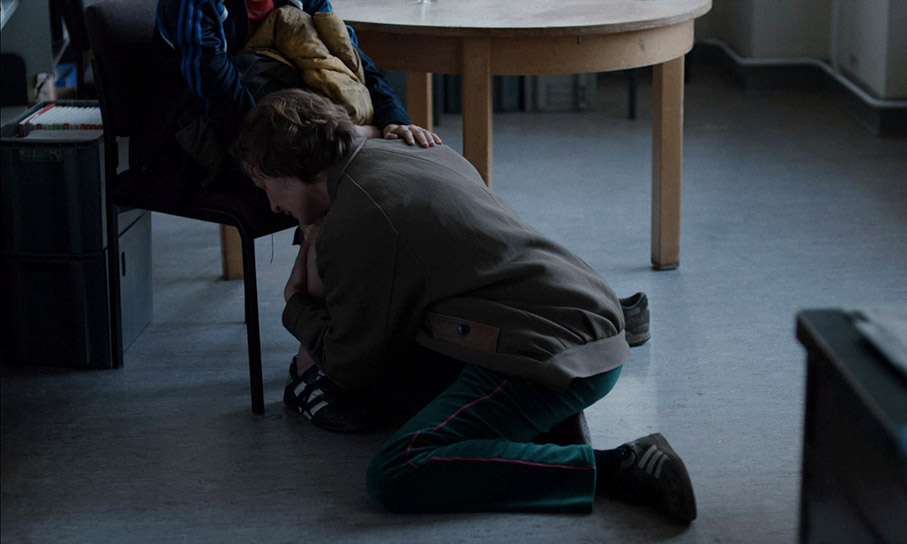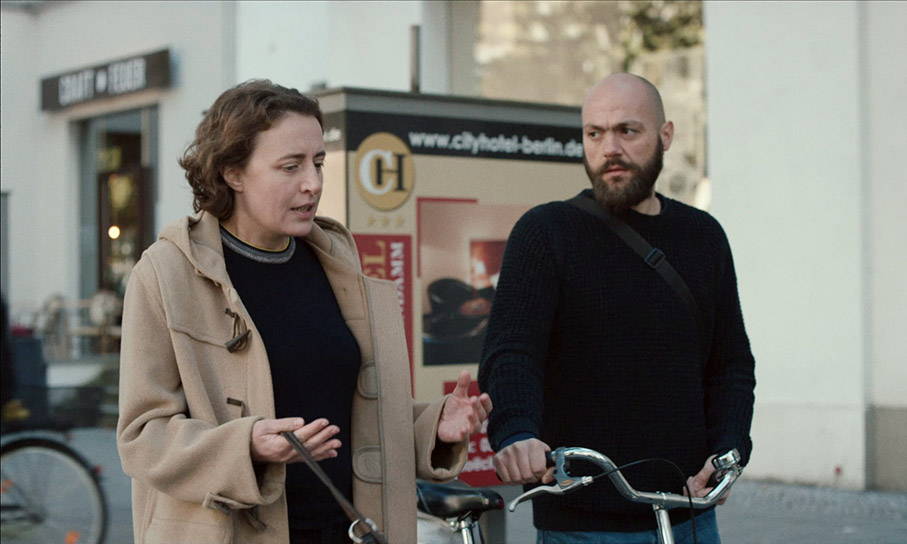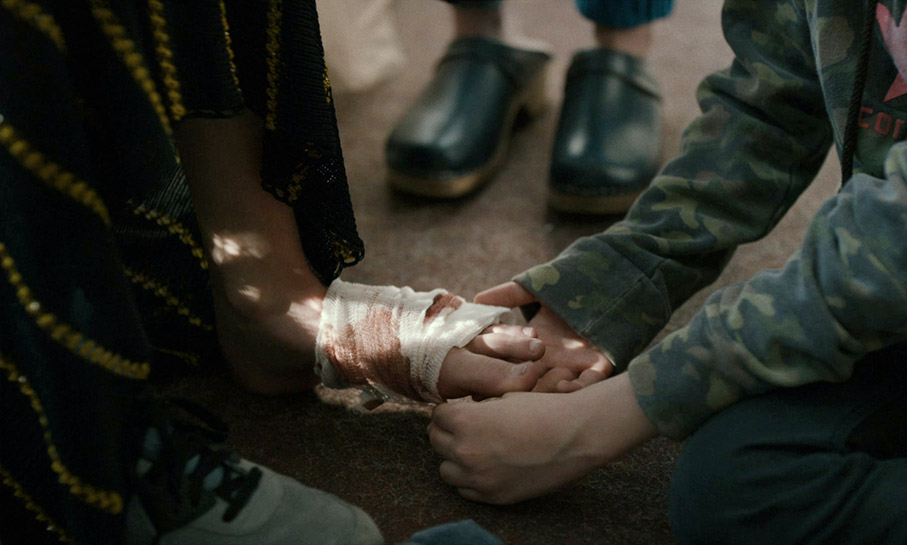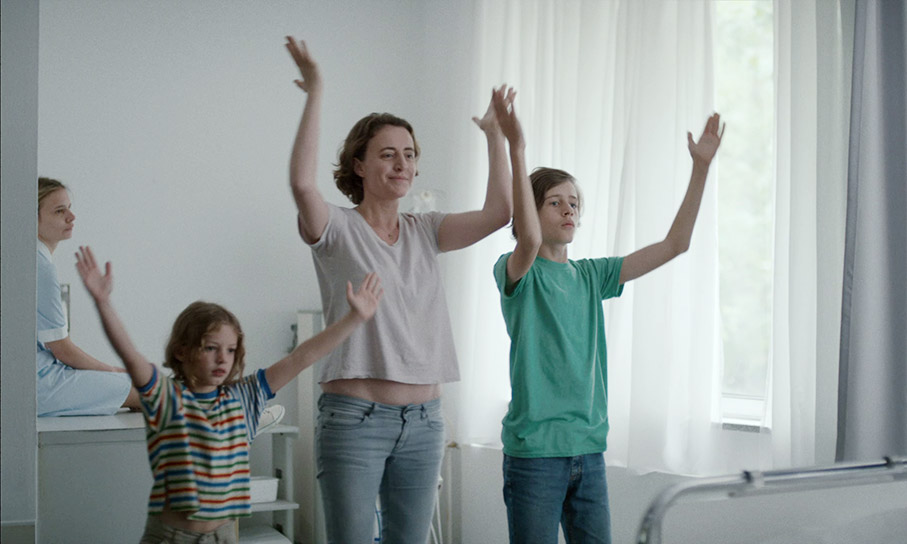|
A dog chases a rabbit through a field. The rabbit eventually pauses, panting from its exertion, and looks around to see if it has successfully escaped its pursuer. A short while later in an abandoned and derelict house, a donkey ambles into a room and pauses. On the floor before him is the rabbit being torn apart by the hungry dog. Eventually the dog finishes its meal and wanders off, and the donkey slowly turns and stares through a glassless window at the countryside beyond. There’s an inescapable anthropomorphic element to this symbolic opening sequence of the intriguingly titled I Was at Home, But… [Ich war zuhause, aber], the tenth feature from director Angela Schanelec. For me, it plays almost like a wordless extract from an alternative take on Animal Farm, one in which a mother wearily observes a destructive act by her troublesome child, then gazes distractedly through a window as if contemplating her situation and an offspring whose behaviour she is no longer able to control.
A couple of minutes later, we’re shown a man standing in a room looking through a window in a similarly distracted manner and from the very same angle. Slouched in a chair on the other side of the frame is a young boy that we have just watched enter the building and sit down to slowly loosen the laces on his shoes. A woman then runs up the stairs and into the room, and as the man departs, the woman is shown kneeling breathless at the boy’s feet and hugging his legs, her posture one of desperation mixed with relief. Even if you’ve somehow not read a synopsis of the film, there are enough clues here for even first-timers to take an educated guess at what these images collectively signify. Keep watching and all becomes more retrospectively clear. The boy in question is Phillip (Jakob Lasalle), and he has just walked into his school after having disappeared for a week. The man gazing through the window is likely the headmaster, and he has clearly contacted Phillip’s mother, Astrid (Maren Eggert), who arrives in a fluster and is overcome with relief that her missing son is safe after all. We’re shown just enough to allow us to work out the essentials of what has occurred, though it does take a second viewing to really appreciate how much information is conveyed with what initially seems to be so little.

It’s a scene whose pared-down approach to storytelling proves a template for much of what follows, where nothing is overtly stated and we’re left to piece the story together from the fragments provided. This refusal to spell things out also leaves a lot of questions open to audience speculation, only some of which are answered during the course of the film. There’s no scene, for example, in which Phillip’s disappearance is discussed in any detail, primarily because the focus of the film is not the incident itself but the impact of its aftermath on his mother. There’s none of the expected expository talk here, with information gleaned instead from observed actions and snippets of dialogue. As an audience, we have come in at a late stage of a drama whose details were clarified outside the timeframe of the film.
It’s an approach that can initially prove distancing and will doubtless infuriate some, but one that I became increasingly seduced by, as seemingly disconnected moments later take on new meaning and raise interesting questions about the characters concerned. One such sequence begins with a close-up of an infected foot being bandaged. There’s no introductory wide shot and the hands are clearly those of a child rather than a medical professional. The bandage being applied is already bloodstained, clearly indicating that this is not a fresh dressing but a reapplication of one that the injured party has probably been wearing for too long. When the bandaging is complete, it is held in place not with a plaster or a safety pin, but a rubber band. Observing the whole process is a second (or is that third?) child, whose feet can be seen in the background wearing oversized adult shoes. Two shots later, Phillip is observed from a distance standing by a busy roadside and being physically supported by two of his schoolfriends. A taxi then pulls up and a limping Phillip is helped into the vehicle, where he is joined by one of his friends, leaving the other to cycle off. In the next shot, the two friends are at a hospital asking about Phillip and, in a rare piece of verbal exposition, a nurse responds, “Is that the boy with sepsis?” and tells them that he is in surgery. As the two children exit the hospital, they are passed by Phillip’s mother, who is purposefully heading into the building. So what can we draw from this? It seems likely that during his disappearance Phillip injured his foot, perhaps by stepping on a rusty nail or another sharp object, and that the wound has subsequently become infected. Instead of revealing this injury to his mother, Phillip elected to live with the pain until the infection made it impossible for him to walk. Again, he chose not to tell his mother (this itself raises questions that may or may not relate to why he left) and instead confides in his friends, who check the wound, redress it with the bandage that they or Phillip himself probably applied some time earlier, and eventually make the decision to get him to hospital, where the doctors contact his mother to tell her that her son has been admitted. It’s worth noting that I was able to deduce the majority of this from just three wordless shots and the recall it triggers to the opening scene shot of Phillip slowly loosening his shoelaces.

Disrupting this minimalist clarity, however, is a story thread involving the rehearsals for a production of Hamlet by members of Phillip’s class, sequences that initially feel like interruptions to the main story and whose connection to it are open to interpretation. There’s a case to be made for reading them as part of an underlying meta-commentary on the nature of acting, one that peaks in a thought-provoking monologue delivered by Astrid on its lack of truth delivered as part of a compelling ten-minute walk-and-talk shot in which the previously taciturn Astrid lets rip to her film director friend Jorge (played by real-life filmmaker Dane Komljen) about what she regards as the failings of his latest work. It’s criticism that Jorge patiently listens to and calmly disagrees with, but as the two part company, clearly still friends in spite of their differing viewpoints, there’s a sense that he is a little taken aback by the passion of Astrid’s outburst. As a theme, this is further developed by the news that Astrid’s late husband was a theatre director and that it’s been just two years since she lost him to a terminal illness, the trauma of which has been re-awakened by Phillip’s disappearance. As she visits her husband’s grave late one evening, she recalls – in the film’s only flashback and its most magically upbeat sequence – when she visited him in hospital and she, Phillip and Phillip’s younger sister Flo (Clara Möller) entertained him with a choregraphed dance to M. Ward’s acoustic version of David Bowie’s Let’s Dance. It’s a final performance staged for a man whose professional life has revolved around acting and theatre, delivered by people wearing masks of cheerfulness to disguise how they really feel about the situation. You could also argue that the play-within-a-play element of Hamlet feeds into this, and you can read what you like into the fact that both Hamlet and Philip have lost their fathers and have seen their respective mothers take up with another man, which in Astrid’s case is good-looking tennis pro Finn (Jirka Zett).
A second and seemingly more disconnected story thread involves one of Phillip’s teachers, his faltering relationship with his current girlfriend, his desire to have children and how it conflicts with his girlfriend’s belief that bringing a child into the world just because they want one is mad. This did have me wondering if I was being asked to draw parallels to Astrid’s younger days and wonder whether she and her late husband had a similar discussion about whether or not they wanted children – indeed, were in not for the fact that the teacher was first seen in the school staff room, I might well have mistaken these scenes for flashbacks. It’s also hard not to see parallels with Astrid’s situation when the girlfriend claims that having a child would not change the fact that she is ultimately alone.
Phillip’s week-long disappearance is never directly discussed, so we never learn for sure why he departed, where he went or what happened to him during his absence, and the small hints that are dropped remain open to interpretation. A late-night meeting of teachers in which the question of whether to expel an unnamed pupil may not even be about Phillip at all, but if it is (and if not, its inclusion is a little abstract) then it raises questions about why such a drastic measure is being considered for what on the surface is nothing more than a week’s absence. And the scene’s opening line of dialogue – “So, it’s okay to kick him out of school even if we care?” is loaded with suggestion, as is the above-mentioned teacher’s almost too-quick response of, “Yes.” By way of response a couple of days later, Astrid walks into the staff room and addresses the assembled staff, fully aware that they have to make “an informed judgement” but assuring them that they cannot possibly understand something that they have not been through and that has not personally affected them. Again, are we just talking about the consequences of Phillip’s absence from class or something more profound that has not been revealed within the film?

Ultimately, such things are of relatively minor importance in a film that is not primarily about the disappearance of a child but it’s impact on his mother, who is still in the fallout of the grief brought on by the premature loss of her husband. Initially, she puts a brave face on the meltdown she is constantly in danger of suffering, asking Phillip’s teachers to be reasonable in their decision and returning to a class she has been taking that we can presume she ceased attending after Phillip went missing (on her return, her first words to those she meets are, “He’s back with me, he’s safe”). Some signs that she is struggling to cope are not easily identifiable as such to those who’ve not been through the grieving process. In a pair of extended sequences that I’ve seen described almost as a comedy relief, Astrid buys a second-hand bicycle from a man who speaks with the aid of one of those electronic voice-boxes you hold against your throat to use. When the bike breaks down as she is riding it home, Astrid dumps it in the grass by the side of the road but later retrieves it and returns it to the seller, whom she relentlessly badgers for a refund, something he is oddly reluctant to provide. That these scenes go on for as long as they do may confuse some, and I can appreciate why. Yet as someone who has experienced his share of personal tragedies, I know how easy it is to ascribe inflated importance to trivial things when you are trying to hold it together following the death of a loved one, and for me that’s something these sequences really seemed to nail. Indeed, I became so caught up in Astrid’s quest to get a refund that when the seller relents and offers to transfer the money to her the following week and she gratefully writes down her bank account details, I was screaming “No! Don’t do it!” at the screen in the expectation that in her distracted state she was handing over information that would see her fleeced of every penny she owned. This surface control finally cracks after Astrid brings Phillip home from hospital and she blows up at her young daughter for using the stove while she was out and angrily shakes off repeated attempts by Flo and Phillip to comfort her. The following morning she’s in the kitchen having breakfast with Finn when Flo’s giggling at being tickled by Phillip mutates into playful screams, which prompt Astrid to instant panic, fear that quickly mutates into fury and sees her physically eject them from the apartment.
Although this is Schanelec’s tenth feature film as director, I’ll admit to being new to her work, and as I often do with films I’m not familiar with, I went in cold and chose to only read about the film and its director after completing my first viewing. It’s then that I learned that Schanelec is regarded as one of the Berlin School of filmmaking’s more austere stylists (the walk-and-talk tracking shot aside, Schanelec clearly favours the unblinking gaze of the static camera) and that some have compared her work to late period Bresson. Both observations feel appropriate and indicative of how opinion is likely to be divided over a film that offers none of the easy viewing pleasures of mainstream cinema, requiring instead that its audience pay close attention and piece together the narrative from the snippets of information provided. I went into the film knowing little about it, and while I was initially uncertain, I became increasingly seduced by the very thing that some will doubtless find distancing. Nothing is laid out on a plate or explicitly stated here, yet all the information required to make sense of what is unfolding, as well as the impact it is having on Astrid, is there in the smallest details and what may initially seem like inconsequential moments. I Was at Home, But… is absolutely not going to work for everyone, but I found it quietly compelling cinema, minimalist filmmaking with purpose and a genuine compassion for its emotionally tormented central character and those that, despite everything, she so deeply cares for.
Framed in the film’s original aspect ratio of 1.66:1, the 1080p, director-approved transfer on Second Run’s Blu-ray is as close to pristine as you could hope for, having very crisp reproduction of fine detail, a largely naturalistic if slightly muted colour palette, and finely-balanced contrast with robust black levels. There's a toned-down look to the brightness in much of the film, but detail still visible even in the darkest of (Astrid lying at her late husband’s graveside is a good example). I’m assuming that the film was shot digitally, which would count for the lack of an obvious film grain.

Two soundtrack options are offered in the shape of Linear PCM 2.0 stereo and DTS-HD Master Audio 5.1 surround. Both are sonically in excellent shape, with a strong dynamic range, clear reproduction of dialogue and location sound, and a rich rendition of the two songs used, but the surround track does feel more expansive, with the rear speakers put to inclusive use for ambient sound in sequences involving exterior traffic noise or the reverb of a swimming pool.
Optional English subtitles kick on by default, but can be switched off either on the main menu or on the fly if your German is up to the task (mine definitely is not).
An Interview with Director Angela Schanelec (31:56)
Filmed in London in 2020, this interview with director Angela Schanelec is conducted by Second Run’s Mehelli Modi, and although it does explore aspects of Schanelec’s filmmaking in general, the primary focus is I Was at Home, But…, with the conversation all in English. Schanelec talks about how the film developed from a single image, the inspiration for the animal opening sequence, her preferred process of step-by-step writing, tight shooting schedules that leave no room for improvisation, casting and working with children and non-professional actors, and more. Interestingly, when asked if the film is about motherhood, her answer is an affirmative, “Yes,” a response she then usefully expands on. A welcome companion to the film.
Short Films
Three early short films directed and photographed by Angela Schanelec have been included here, none of which have a traditional start-journey-conclusion narrative structure. All three have some dust marks and blemishes but are otherwise in largely good shape, although the soundtrack of Far Away has a several loud pops of damage and a picture that undergoes a couple of violent jolts.
The 1991 Lovely Yellow Colour [Schöne gelbe Farbe] (4:37) offers the flipside of primarily visual approach taken in I Was at Home, But… and is driven by narration, as a woman reflects on her relationship with a man she has just split up with, which is accompanied by what feel like the indistinct imagery of memory.

In the 1992 Far Away [weit entfernt] (9:11), a woman has a phone conversation with a friend about a trip they both experienced very differently, then steals the pocketbook from a man who has just narrowly missed having his car stolen and goes to a music store to listen to a record that she may or may not buy. Stylistically closer to I Was at Home, But… than Lovely Yellow Colour in its focus on long-held and largely static camera shots, but there’s an almost Kaurismäki quality to the deadpan stillness that gives rise to a couple of dryly funny moments.
Prague, March ’92 [Prag, März 92] (14:45) provides a distinctly non-travelogue view of the city of the title, its streets, its trams, its small businesses, and its people, which are given a sombre feel by the gloominess of the print. This is bookended by spoken quotes from Bohumil Hrabal's essay, The Magic Flute, and the project itself was apparently inspired by a seminar delivered by acclaimed German filmmaker Peter Nestler.
Also included is a Booklet containing a thoughtful and detailed essay on Angela Schanelec and I Was at Home, But… in particular by freelance film programmer, critic and journalist Carmen Gray.
Not a film, I suspect, for the mainstream majority, but for those who appreciate an approach in which quiet observation and character detail is used to tell a personal rather than a generic story, for my money I Was at Home, But… really delivers. A quick skip through reactions to the film confirms that it’s going to alienate and even annoy the hell out of some, but over the course of its unhurried 105-minute run time I found myself increasingly warming to director Schanelec’s approach, something a second viewing only served to cement. Second Run’s Blu-ray features an excellent transfer, and the inclusion of the interview with Schanelec and three of her early short films is a bonus. Not for everyone, sure, but definitely recommended for those who are game.
|